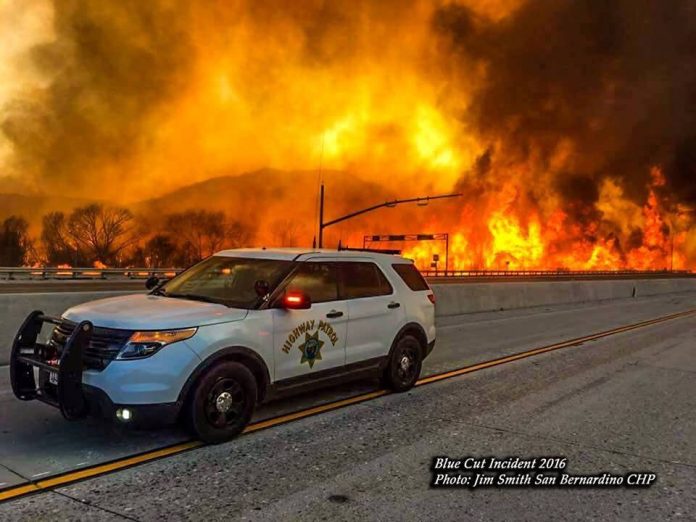
Californians had prayed for an El Niño weather pattern to deliver snow and rain to a state beset by historic drought and tough water restrictions. And last winter, down it came.
It snowed in the high Sierra Nevada Mountains and poured in the north near San Francisco, filling reservoirs that were critically low. It sprinkled in the arid south near Los Angeles, allowing wild grasses to finally sprout. The precipitation was a blessing — and a curse.
By now, the tall grass has dried and hardened into kindling for wildfire. It contains virtually no water and has a “100 percent ignition rate for any spark,” said Janet Upton, a deputy director at the state Department of Forestry and Fire Protection, known as Cal Fire. “We have this fuse to a bomb.”
And the fuse was lit Tuesday in the windy Cajon Pass of San Bernardino County, just east of Los Angeles. The Blue Cut fire that started along a ridge, initially burning only a few acres, roared to more than 30,000 acres by the next day, exhibiting aggressive behavior that one fire official said was more extreme than anything he’d seen in 40 years of firefighting. Some 82,000 residents were ordered to evacuate.
The worry in California is that the Blue Cut is hardly an isolated incident. Invasive species of perennial wild grasses carpet the entire state. The winter wet hit them at the perfect time, just as they were germinating.
But abnormally high summer temperatures and a parched sky have sucked away what little water they still held several months later, state environmental scientists say. In communities as well as up into the hills, the terrain is marked by these grasses, plus shrubs that long ago died of thirst and still-standing trees that died both from lack of water and beetle infestation.
“The drought conditions have caused homeowners to water ration and eliminate the defensible space around their homes,” noted Brendan Ripley, a fire behavior analyst.
It’s all ready to blow.
California recorded 275 wildfires last week alone. So far this year, more than 4,500 fires have erupted, including the Clayton fire that’s still burning north of the state capital after nearly a week. The Blue Cut blaze remains a dangerous inferno, with just a quarter of it contained early Friday. Officials said it had expanded to 37,000 acres.
“We’ve had no respite. The conditions are so dry,” Upton said.
Gov. Jerry Brown (D) initiated an emergency response two years into the drought and allocated an additional $175 million to Cal Fire for fire prevention and response. He assembled a large state-local task force to remove dead trees from areas that historically have burned. One of the group’s focuses also has been the vegetation, which sometimes is as high as 6 feet.
Grass is a superfood for wildfire. “It drops into the grass and starts to ignite,” said Cal Fire Chief Ken Pimlott, one of the commanders guiding the response to the Blue Cut. “If it’s something you haven’t seen, it’s interesting to experience. It’s instant. It happens quickly, an entire area ignites almost at the same time.”
From there, flames move quickly, pushed by winds that almost never die in canyons and passes. They carry fire to “heavier foods” such as chaparral, drought-stressed flowers and shrubs that explode when the fuse hits them. “It throws embers in front of it, and they spark new fires,” Pimlott said.
The result is a fire with unusually beastly behavior in the heat. In rural San Bernardino, it has climbed hills, pulling itself up by reaching for bushes. “In my 40 years of fighting fire, I’ve never seen fire behavior so extreme as it was yesterday,” Mark Peebles, a San Bernardino Fire Department battalion chief, said Wednesday.
“We are seeing aggressive and explosive fires,” noted a department spokesman, Bob Poole. “We used to estimate a fire reaching an area in a half hour. Now we see it get there in 10 minutes.”
More than other western states, California is caught in a perfect storm of conditions that causes big, angry fires. Droughts are natural there and throughout the West and Southwest, but studies show that global warming has amplified the heat, causing temperatures to rise steadily since the early 1970s while precipitation remained the same.
That assures high-temperature years will intersect more often with low-precipitation years, which is a recipe for drought and a bigger, longer fire season. Meanwhile, the state’s naturally high winds keep blowing, the way a person might blow on a campfire to get it going.
Regardless of the heavy snow and rain dumped on the state in January and February, “California is still in a drought, and in addition to being in a five-year drought we’ve had a prolonged period of dryness,” said Noah Diffenbaugh of Stanford University, who recently authored a temperature study that analyzed historical climate data and found California could face drought nearly every year.
What followed the record El Niño snowfall in the northern Sierra Nevadas was “near-record snow melt this spring,” Diffenbaugh explained. “The effect of high temperatures create dry conditions in the summer and rapid water evaporation from soil.”
Beyond the 66 million dead trees that the U.S. Forest Service estimates for California are another 30 million that are water stressed, Stanford scientists have said. They have very little moisture, which means they’ll burn more easily.
Through much of the state, the hills are full of conifers turning reddish brown and vegetation that may look green but is actually dead. There appears to be no end to fire season given the drought.
“We’re going to deal with this for the next 15 years,” Upton said. “No amount of rain will bring back the dead trees.”
(c) 2016, The Washington Post · Darryl Fears
[Featured video via @LALATE / Twitter]

